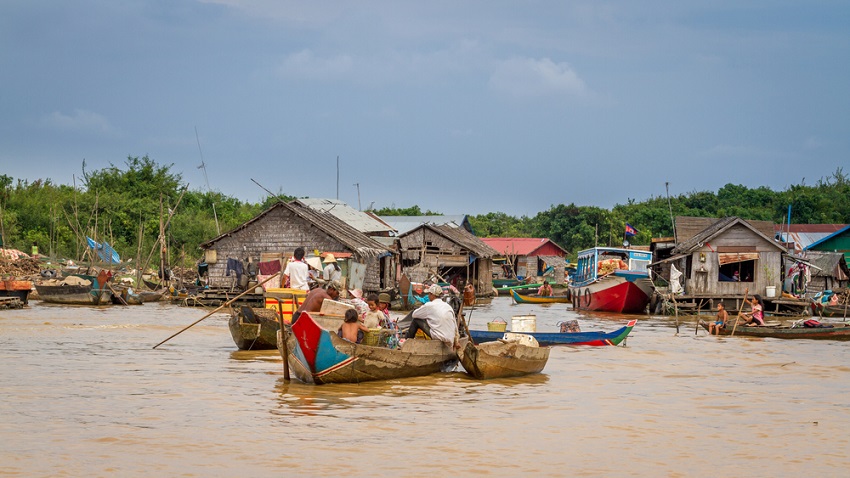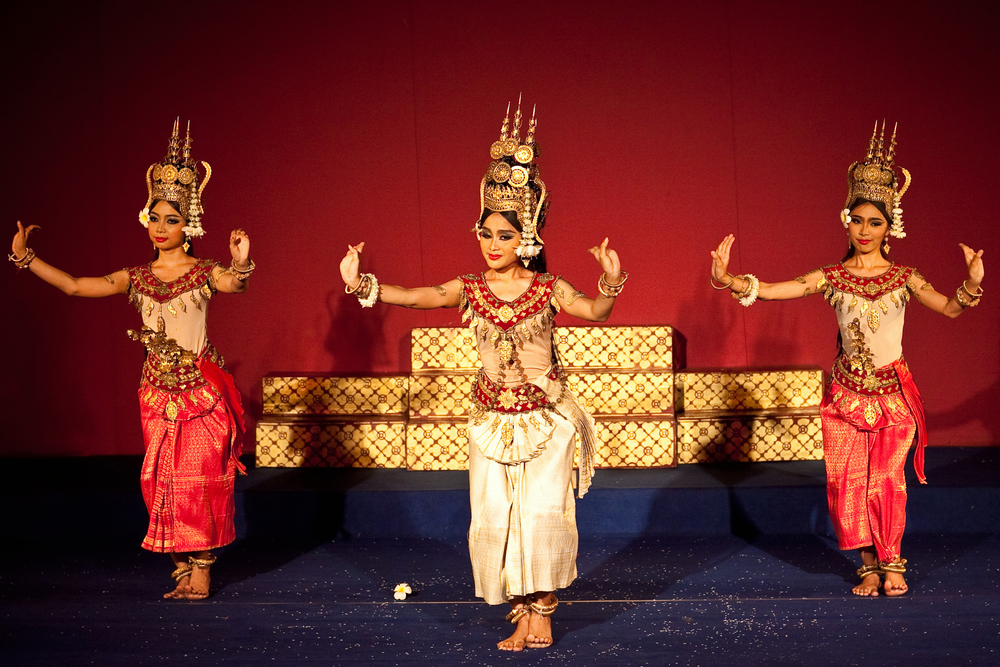Cambodia - fact sheet
General information
Location
Located at the centre of Southeast Asian region, Cambodia is bordered by Thailand to its North (Ubonratchathani, Srisaket, Surin and Burirum) and Laos (Attapeu and Champasak). To the east, it is bordered by Vietnam (Kon Tum Province, Pleiku, Gia Lai, Dak Lak, Dak Nong, Tay Nihn, Long An, Dong Thap, An Giang and Kien Giang), while to the west is bordered by Thailand (Sakaeo, Chanthaburi and Trat). To the south, the country stretches a coastal line along Gulf of Thailand.
Area
Cambodia covers the area of 181,035 square kilometres or one-third of Thailand. Its borderline stretches 2,000 kilometres with 798 kilometres forming a boundary with Thailand.
Capital city: Phnom Penh
Population: 14.67 million
Currency: Riel
Official language: Khmer
Religion: Theravada Buddhism (Maha Nikaya makes up 90% and the rest is Dhammayuttika Nikaya)
Monarch: Norodom Sihamoni
Prime Minister: Hun Sen
Legislature: constitutional monarchy that employs parliamentary democracy
Administrative divisions
Cambodia has a capital city, Phnom Penh and other 23 provinces: Kratie, Koh Kong, Kandal, Kampong Cham, Kampong Chhnang, Kampong Thom, Kampong Speu, Kampot, Takeo, Ratanakiri, Preah Vihear, Battambang, Pursat, Banteay Meanchey, Prey Veng, Mondulkiri, Stung Treng, Svay Rieng, Siem Reap, Oddar Meanchey, Pailin, Kep and Preah Sihanouk. Each of the provinces has its own municipality called ‘Krung’. The famous cities considered ‘Krung’ are Krung Poipet in Banteay Meanchey Province, Krung Bavet in Svay Rieng Province and Krung Suong in Kampong Cham Province.
Society, culture and tradition
Cambodian society
Cambodian society consists of many different ethnic groups in which Khmer is the dominant group found living across the country. Most of which make a living by agriculture and fishery. Over a past decade, a great number of the Khmers have migrated into larger cities like Phnom Penh, Battambang, Kampong Som and Kampong Cham. Despite the fact that the Khmer people appear more influential in politics and culture of this country, their financial status is opposite. The Khmers are poorer than the Cambodian-Vietnamese and Cambodian-Chinese.
The Vietnamese make the second largest population in the country found settling in big cities and around Tonle Sap. Another influential ethnic group is the Cham Muslims emigrating from Vietnam to resettle along Sap River and Mekong River, especially northern Phnom Penh. Most of the Chinese Cambodian live in both large and small urban areas where they make a living out of trading, allowing them to become the most influential group in the economy of Cambodia.
Other ethnic minorities are known as Khmer Loeu comprising of 30 indigenous groups living in Cambodia. Their settlement sites are among remote and mountainous areas where languages, cultures, beliefs and ways of life are ethnically different.
Food culture
Though Cambodia’s climate and geographical features being slightly different from Thailand’s contribute to similar kinds of grains and cuisines, its food is influenced by French, Indian, Chinese and Vietnamese food culture.
Local areas provide ingredients for food such as sweet basil and kaffir lime leaves. Freshwater and marine fish are the main protein source for the Cambodians since one of its distinctive geographical features includes large water bodies distributing plenty of fish. Tonle Sap, for example, naturally extends the territories and abounds with fishes in the rainy season. However, the lake dries up in November. The Cambodians have learned to survive the drought as they preserve food such as salted fish, sun-dried fish, sour-flavored fermented fish and pickled fish called ‘Prohog’. While meats like pork, beef, duck and chicken can also be found, they are more expensive than the fish dishes. Sausage made from pork is called ‘Twaco’.
In addition to the main ingredient like fish, Cambodia is rich in fruits and vegetables. They are both used as ingredients and featured in Cambodian side dishes. Mangosteens and durians are very popular among the people while rice is the main course. Noodles with soup called ‘Kuy Teow’ and French baguette called ‘Nompang’ are other preferable cuisines. Sticky rice is sweetened and served with durian as a set of dessert dish. Rice noodles are called ‘Nompanjoh’.
The cultural heritage Cambodia adopted from India is spices and spice pastes such as red paste with coconut milk called “curry” usually served with cooked rice or sliced breads. The curry is also seen with breakfast like canned fish, egg, sandwich, ham and grilled meat. It is obviously one of the French influences adopting from those colonial days. Cambodian food usually adjust the seasoning with “Kreung” or grinded spices in which pepper is heavily used rather than guinea pepper to create hot and spicy flavors. Improving the flavors, shrimp paste and fish sauce are also featured. However, the court dish recipes favor using different kinds of spices and herbs such as ginger, galangal, lemon grass, kaffir lime, lemon, shallot and garlic as it is believed to improve and adjust a smoother flavor and mouthwatering smell to the dishes.
The influences of eastern food especially Chinese food originated the noodles dishes like Chinese noodles, fried noodles and Kuy Teow or Cambodian noodles. For example, Mi Katang is a Guangdong-like noodle dish, while Mi Kola is a vegetarian noodle dish seasoning with soy sauce and garlic served with pickles and eggs. Baysa is fried rice with Chinese sausages or any kind of meats seasoning with soy sauce and garlic. Vietnamese food has also played a vital role in shaping Cambodian food as Niam bears a resemblance to Vietnamese spring rolls. Banhoy is large strips of streamed noodles filled with mint leaves, grinded peanuts, pickles and sliced omelets served with fish sauce. Cambodian coffee mostly uses condensed milk. However, it has started favoring non-dairy creamer due to the Thai influence. Cambodia sees foreign food influences over the city as the restaurants and food vendors on street are blooming and spreading everywhere.
Costume culture
Sompot or a long piece of fabric worn as a skirt has been seen in Cambodia since its ancient time. This one-piece costume covering the lower part of body can be traced back to Funan time when it was influenced by Indian costume culture. 4 It can be simply worn as a loincloth and the materials woven into the fabric differentiate classes of the people.
Kroma fabric is the Cambodian necessity over other everyday-life garments. It is both cotton and silk woven and the pattern is typically a grid. Each province of Cambodia has their own unique Kroma pattern. It is the all-purpose piece of cloth sheltering sunlight, raindrops and strong wind. Some prefer using it as a blanket, a bandage, a Sarong or shorts. In addition, its multipurpose includes carrying a baby on the back, being a shopping bag and even a hammock.
Music and performing art culture
Cambodian music was flourishing in both court and commoner levels serving the traditional and entertaining purposes. Those include playing encores for the wedding receptions, playing the Aria song while a ceremony of spirit possession is being performed, singing and exchanging verses of the Ayai song and telling a story through the Chariang Chap Paiy song. The court features folk dancing, traditional dancing, Khon or the classic masked play and Nang being similar to the shadow play while the religious ceremonies feature Pinpiat Gamelan and Mohaori Gamelan.
The royal Cambodian dancing art shares some similarities with the royal Thai since the two have exchanged and inspired each other so that the form of arts somehow bears the shared distinctive features.
Festivals and traditions
New Year Festival
The New Year Festival or Songkran that the Cambodian call “Bon Chol Chanum” is a shared festival of the ASEAN countries like Cambodia, Laos, Myanmar and Thailand. Cambodia’s New Year is held after the harvest around early April when it is going to take 3 days with specific dates set on the lunar calendar. Making merit, offering food to the monks and sprinkling water onto the Buddha images are what is expected to be seen during the festive season for the people believe these would bring good luck along the coming year. The pouring water on the hands of the revered elders and asking for a blessing ceremony takes place and it is a great opportunity to clean and redecorate the houses for the New Year.
Chinese New Year
Cambodia does not take the Chinese New Year as its public holidays. However, the celebration among the Chinese-Cambodian and the Vietnamese is taking place. They clean and redecorate their houses with a belief it would bring good luck on the new year day. Family gathering, cooking family meals, lion dances, lighting firecrackers are also seen while the people go to the temples and ask for blessings at night time.
Ploughing Ceremony
Cambodia’s Ploughing Ceremony is held in May in Phnom Penh marking the beginning of the harvesting season. The ceremony is one of the Brahman ceremonies giving a sign the harvesting season is starting now. The kings also attend the ceremony to draw good luck and to show supports to those going to plough their soil. In general, the kings perform the ceremony along with the Prime Minister and government officials. In case that that year the king are unable to attend the ceremony, the high-ranking officials would perform the ceremony as the Ploughing Lord. People from all directions come and witness such sacred Brahman ceremony featuring a procession, the Ploughing Lord making predictions and the sacred oxen offered different kinds of food to predict agricultural productivities as of that year.
Cambodia’s Merit-Making for the Deceased Festival
The Cambodians call a ritual in which merit making is offered and transferred to the deceased relatives “Bon Pro Chum Ben” while the Cambodian-Thai know it as “Sandonta Festival”. It is a crucial festival to all Cambodians beginning on the first night of the waning moon of the tenth lunar month until the 15th night of the waning moon. The Cambodians go to the temples and offer food to the monk everyday as it is believed the merit they are making is to be transferred to their deceased relatives. The more food they are giving to the monk, the better it will become.
Most of the temple-goers are women. They are culturally dressed in silk holding food trays, joss sticks and candles meant to offer to the monks. The festive desserts are buns of sweetened sticky rice stuffed with banana, nuts or sliced coconuts. The elders prefer staying overnight at the temples where they would help and cook caramel-like stick rice and place it around the temples for the Peta, hungry ghosts. Believing their deceased relatives would get more, the Cambodians usually perform seven days of merit making. For those working and living abroad, the Bon Pro Chum Ben is also carried out every year so that they can gather and make merit.
Independence Day
The Cambodians celebrate the Independence Day on 9th November each year since it marks achieving independence from France in 1953. It is a proud moment of the Cambodians to finally declare its own sovereignty, so every street on the first week of November is seen decorated. The joyous celebration on 9th November features parades and fireworks at night.
Annual Boat Race
Annual Boat Race in Cambodian is known as Bon Om Took while it is Water Festival to foreigners. It is 3 public holidays starting on the 14th waxing night in the twelve lunar month to the first waning night of the first lunar month. How the festival is held should be agreeable with the lunar calendar as well as a change of seasons. Mekong River running down to Tonle Sap earlier would run reverse resulting in a shrinking area around the lake. Bon Om Tuk is the biggest festival of the year featuring the boat race taking place in front of the palace where the boats from different villages come and join the race.
Bibliography
เขียน ธีระวิทย์, และสุนัย ผาสุก. 2543. กัมพูชา ประวัติศาสตร์ สังคม เศรษฐกิจ ความมั่นคง การเมืองและการต่างประเทศ. กรุงเทพฯ : สำนักงานกองทุนสนับสนุนการวิจัย และ สถาบันเอเชียศึกษา จุฬาลงกรณ์มหาวิทยาลัย.
แชนด์เลอร์, เดวิด พี. 2543. ประวัติศาสตร์กัมพูชา. แปลโดย พรรณงาม เง่าธรรมสาร และคนอื่นๆ. กรุงเทพมหานคร: มูลนิธิโครงการตำราสังคมศาสตร์และมนุษย์ศาสตร์.
ดวงธิดา ราเมศวร์. 2555. ประวัติศาสตร์ประเทศในกลุ่มอาเซียน: ไทย ลาว พม่า กัมพูชา. กรุงเทพฯ : แพร-ธรรม.
ธีระ นุชเปี่ยม. 2542. การพัฒนาเศรษฐกิจและการเมืองกัมพูชา. กรุงเทพฯ : คบไฟ.
มัลลิกา พงศ์ปริตร, บรรณาธิการ. 2544. ลาวและกัมพูชา. แปลโดย พวงนิล คำปังสุ์. กรุงเทพมหานคร: สำนักพิมพ์หน้าต่างสู่โลกกว้าง.
รัชดา ธราภาค. 2555. ราชอาณาจักรกัมพูชา. กรุงเทพมหานคร: สำนักพิมพ์สถาพรบุ๊คส์
สุธาชัย ยิ้มประเสริฐ. 2556. กัมพูชา. กรุงเทพมหานคร: ชมรมโดมรวมใจ.





